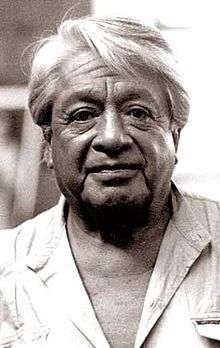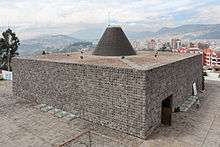Oswaldo Guayasamín
| Oswaldo Guayasamín | |
|---|---|
 | |
| Born |
Oswaldo Guayasamín Calero July 6, 1919 Quito, Ecuador |
| Died |
March 10, 1999 (aged 79) Baltimore, Maryland, U.S. |
| Nationality | Ecuadorian |
| Notable work | Modern Artist Hammered Silver Plate Choker with Turquoise-accent[1] |
| Awards | Premio Eugenio Espejo (1991) |
Oswaldo Guayasamín (July 6, 1919 – March 10, 1999) was an Ecuadorian master painter and sculptor of Quechua and Mestizo heritage.
Biography
Early life
Guayasamín was born in Quito, Ecuador,[2] to a native father and a Mestiza mother, both of Quechua descent.[3] His family was poor and his father worked as a carpenter for most of his life. Oswaldo Guayasamín later worked as a taxi and truck driver. He was the first child of ten children in his family. When he was young, he enjoyed drawing caricatures of his teachers and the children that he played with. He showed an early love for art. He created a Pan-American art of human and social inequalities which achieved international recognition.
He graduated from the School of Fine Arts in Quito as a painter and sculptor. He also studied architecture there. He held his first exhibition when he was 23, in 1942. While he was attending college, his best friend died during a demonstration in Quito. This incident would later inspire one of his paintings, "Los Niños Muertos" (The Dead Children). This event also helped him to form his vision about the people and the society that he lived in.
Art career
Guayasamín won the first prize at the Ecuadorian Salón Nacional de Acuarelistas y Dibujantes in 1948. He also won the first prize at the Third Hispano-American Biennial of Art in Barcelona, Spain, in 1955. In 1957, at the Fourth Biennial of São Paulo, he was named the best South American painter.
Guayasamín met Jose Clemente Orozco while traveling in the United States of America and Mexico from 1942 to 1943. They traveled together to many of the diverse countries in South America. They visited Peru, Brazil, Chile, Argentina, Uruguay and other countries. Through these travels he observed the indigenous lifestyle and poverty that appeared in his paintings.
In 1988, he painted a very controversial mural depicting the history of Ecuador. The Congress of Ecuador asked him to do so. However, the United States Government criticized him because the one of the paintings showed a man in a Nazi helmet with the lettering "CIA" on it.[4]
The artist's last exhibits were inaugurated by him personally in the Luxembourg Palace in Paris, and in the Palais de Glace in Buenos Aires in 1995. In Quito, Guayasamín built a museum that features his work. Guayasamín's images capture the political oppression, racism, poverty, Latin America lifestyle, and class division found in much of South America.

Guayasamín dedicated his life to painting, sculpting, collecting; however, he was an ardent supporter of the communist Cuban Revolution in general and Fidel Castro in particular. He was given a prize for "an entire life of work for peace" by the United Nations Educational, Scientific and Cultural Organization. His death on March 10, 1999 was marked by a day of national strikes by the indigenous people (whom he spent his life supporting) and other sectors of society, and was considered a great loss to Ecuador. He is still lauded as a national treasure.
In 2002, three years after his death, Guayasamín's masterwork, La Capilla del Hombre ("The Chapel of Man"), was completed and opened to the public. The Chapel is meant to document not only man's cruelty to man but also the potential for greatness within humanity. It is co-located with Guayasamín's home in the hills overlooking Quito.
References
- ↑ "Modern Artist Hammered Silver Plate Choker with Turquoise-accent".
- ↑ Organization of American States, Pan American Union Published by Organization of American States (1982). Américas. p. 40.
- ↑ Estrada, Daniela. Chile: Exhibit to Celebrate Indigenous Art. Inter Press Service. 2008 (retrieved 3 Nov 2009)
- ↑ Los Angeles Times, December 09, 1989
External links
- Oswaldo Guayasamín.org.
- Facebook Fan Page -Oswaldo Guayasamín oficial.
- Facebook Fan Page - FUNDACIÓN GUAYASAMÍN.
- Oswaldo Guayasamin biography
- Chapel of Man (Spanish and English versions)
- La Capilla del Hombre.com.
- The Guayasamin museum and Capilla del Hombre- Quito
- Of Rage and Redemption: The Art of Oswaldo Guayasamín
- Oswaldo Guayasamín gallery (95 works in good resolution, Spanish)